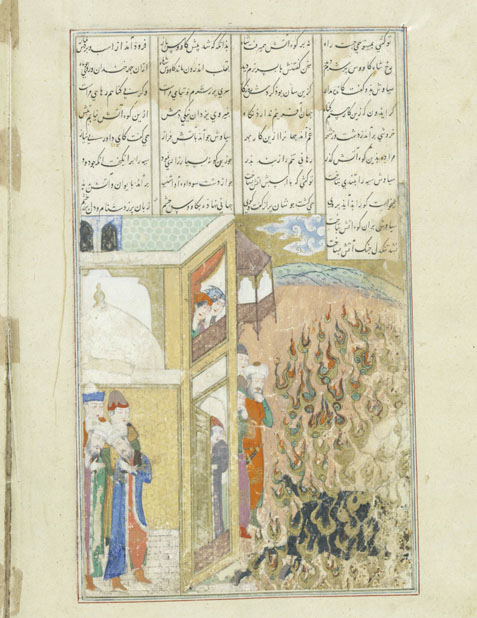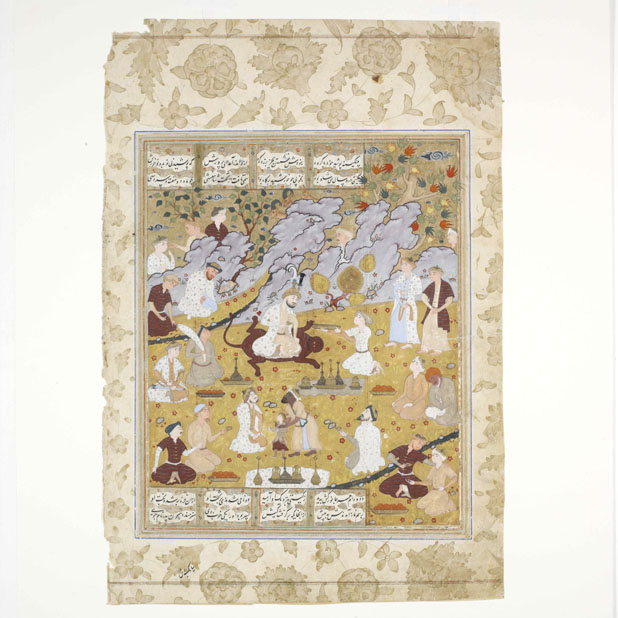Shahnama: The Persian “Book of Kings”
Want to find out more about the latest research and discoveries happening at the ROM? Mark your calendars for the 33rd annual ROM Research Colloquium coming up on February 3, 2012.
Karin Ruehrdanz, Curator of Islamic Arts in the ROM’s Department of World Cultures tells us a little bit about her upcoming colloquium presentation, Shahnama: The Persian “Book of Kings”

This is the only complete Shahnama manuscript in the ROM’s collection. It is opened at the illustration showing the fire ordeal of prince Siyavush (opaque water-colour, ink, and gold on paper), Shiraz, Iran, 1444, 967.315.3. © Royal Ontario Museum, 2008.
What are you going to talk about at the colloquium this year?
I am going to talk about paintings which were inspired by the famous Persian heroic epic Shahnama, or “Book of Kings”. They were created as illustrations to manuscripts containing the over 50,000 verses of the Shahnama. Completed by the poet Firdausi about a thousand years ago his great epic shaped the perception of history and of legitimate kingship in Iran and neighbouring cultures over the following centuries. Its highly popular stories were visualized since the 14th century.
The ROM will present some Shahnama miniatures of its collection in a special exhibition which will open at the end of February. We are fortunate to also include in the show paintings belonging to the Rare Books and Special Collections of McGill University Library and the Montreal Museum of Fine Arts.
How did you first become interested in this topic?
My lifelong fascination with the Shahnama began decades ago when I became aware of the paradigmatic function of those manuscripts. Because of the importance of the text in Iranian society a careful study of all aspects of the illustrative cycle in a particular manuscript reveals how, during its long career, the “Book of Kings” was interpreted at a certain point in history. This, in turn, sheds light on the spiritual climate of place and period and the political rivalries of the time.
What part of your research do you enjoy the most?
Eventually touching a manuscript I had not yet had the chance to inspect. Frequently I have already a list of questions I want “to ask” the book. However, there is always an expectation of surprise, and this is usually answered.

This is a dispersed page from another illustrated Shahnama manuscript. The miniature depicts the first mythical king of Iran, Gayumard, enthroned and surrounded by his courtiers (opaque water-colour, ink, and gold on paper), Shiraz, Iran, 1560-1570, ROM 973.27. © Royal Ontario Museum, 2008.
Do you have a favourite artefact or specimen?
Among the illustrated Shahnamas it is a dispersed and mutilated manuscript of the 1330s. The miniatures of the Great Mongol Shahnama demonstrate how elements of East Asian painting are selectively adopted, transformed and appropriated thereby providing the artists with the means to express far-reaching statements. These reflect a desperate attempt at stabilizing the crumbling Mongol rule over Iran.
The ROM Research Colloquium is annual event that throws the spotlight on ROM researchers with a full day of consecutive 15-minute presentations by ROM experts on their recent discoveries. The program is free and open to the public (Museum admission not included). Karin’s presentation starts at 2pm.
View the full Colloquium schedule and watch for more presenter profiles on the ROM Blog over the coming weeks.
